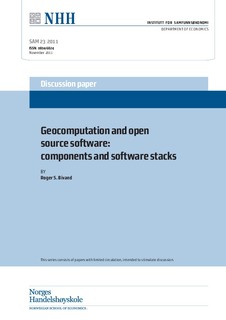| dc.description.abstract | Geocomputation, with its necessary focus on software development and
methods innovation, has enjoyed a close relationship with free and open source
software communities. These extend from communities providing the numerical
infrastructure for computation, such as BLAS (Basic Linear Algebra Subprograms),
through language communities around Python, Java and others, to
communities supporting spatial data handling, especially the projects of the
Open Source Geospatial Foundation. This chapter surveys the stack of software
components available for geocomputation from these sources, looking in
most detail at the R language and environment, and how OSGeo projects have
been interfaced with it. In addition, attention will be paid to open development
models and community participation in software development. Since free and
open source geospatial software has also achieved a successively greater presence
in proprietary software as computational platforms evolve, the chapter
will close with some indications of future trends in software component stacks,
using Terralib as an example. | no_NO |
